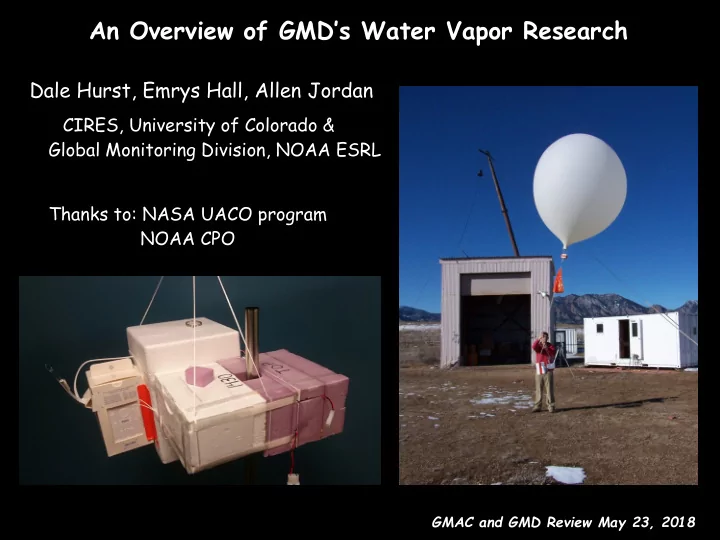

An Overview of GMD’s Water Vapor Research Dale Hurst, Emrys Hall, Allen Jordan CIRES, University of Colorado & Global Monitoring Division, NOAA ESRL Thanks to: NASA UACO program NOAA CPO GMAC and GMD Review May 23, 2018
Scientific Goal Monitor and understand the inter-annual and longer-term variability of water vapor in the upper troposphere and stratosphere Why? Water vapor is a very powerful greenhouse gas, especially in the very cold region near the tropopause SWV influences stratospheric O 3 - polar (PSCs) and global (HO x ) How? Balloon-borne NOAA Frost Point Hygrometers (FPHs) Where? Boulder, Colorado; Hilo, Hawaii; Lauder, New Zealand When? 1-2 soundings per month at each site GMAC and GMD Review May 23, 2018 2/12
Water Vapor in the Stratosphere How does it get there? • Slow vertical transport (Brewer-Dobson Circulation) • Fast cross-tropopause transport (Deep Convective Ice Lofting) • Isentropic transport through tropopause breaks • In situ oxidation of CH 4 and H 2 in the stratosphere How is it removed? • Recirculation (Brewer-Dobson Circulation) • Photo-dissociation by Lyman- α radiation (Mesosphere) • Dehydration within Antarctic vortex during winter/spring What controls its distribution? • Strengths and Phases of BDC, QBO, ENSO (Seasonal, Inter-annual) -> influences on tropical coldpoint (minimum) temperatures • Amounts of CH 4 and H 2 that have been oxidized (Height-dependent) • Strengths of deep convection, Antarctic dehydration, Asian monsoon GMAC and GMD Review May 23, 2018 3/12
Water Vapor – Climate Feedback Tropospheric Water Vapor (>99.9% of atmospheric burden) • Strong IR absorber of outgoing long-wave radiation (OLR) • Increased surface and tropospheric temperatures adds WV • Additional WV absorbs more OLR Stratospheric Water Vapor (<0.1% of atmospheric burden) • Strong IR absorber of OLR, weak thermal emission to space • Climate change to warm the tropical tropopause and increase SWV • Additional SWV absorbs more OLR Changes in SWV have a significant impact on surface temperatures The ~1 ppm (~25%) increase in SWV between 1980 and 2000 would have enhanced the rate of surface warming in the 1990s by ~30% Solomon et al. (2010) GMAC and GMD Review May 23, 2018 4/12
How GMD Measures Water Vapor Balloon - Borne Frost Point Hygrometers (FPH) • 1854: First dew point hygrometer developed in Germany • 1947: First FPH capable of measuring SWV (<10 ppm) • 1960-70s: Mastenbrook and Oltmans developed balloon-borne FPH at NRL • 1980: Oltmans begins routine FPH soundings in Boulder • 1989->: FPH performance improved: digital logic, stable frost control • Every NOAA FPH is built and bench-tested at GMD. 40-50 per year Tube PID Logic FPH Air Flow Tube (also on bottom) Ozonesonde FPH Mirror FPH Cryogen Assembly Radiosonde Dewar (internal) GMAC and GMD Review May 23, 2018 5/12
Where GMD Measures Water Vapor Sodankylä Lindenberg Boulder Boulder Hilo Hilo San José Lauder Lauder 38 NOAA FPH sites Boulder 40°N since 1980 Hilo 20°N since 2010 (~monthly profiles) Lauder 45°S since 2004 Other sites (using CFH) Sodankylä 67°N since 2002 Lindenberg 52°N since 2008 (with >5 years of monthly profiles) San José 10°N since 2005 GMAC and GMD Review May 23, 2018 6/12
Water Vapor Vertical Profiles Altitude (km) Water Vapor (ppmv) GMAC and GMD Review May 23, 2018 7/12
FPH Measurement Accuracy and Uncertainties FPH Measurement Accuracy Laboratory Comparison AQUAVIT-2 (2013) Systematic Random Near-global coverage from 1984 onward from Hall et al. (2016) from Hall et al. (2016) GMAC and GMD Review May 23, 2018 8/12
Scientific Findings updated from Hurst et al. (2011) Trends of 0.20 – 0.25 ppm decade -1 GMAC and GMD Review May 23, 2018 9/12
FPH and CFH vs MLS, 68 hPa Spatial Coincidence Criteria ∆ lat < 2° ∆ lon < 8° Temporal Matching ∆ t < 18h from Hurst et al. (2016) GMAC and GMD Review May 23, 2018 10/12
FPs vs MLS: Post-2010 Drifts Full-Record Biases adapted from Hurst et al. (2016) GMAC and GMD Review May 23, 2018 11/12
Summary WV near the tropopause is a powerful GHG (+feedback) GMD: 1-2 FPH launches/month at 3 sites. 38 years at BLD Only 6 FP sites world-wide with records >5 years Boulder record: SWV increase of ~20% since 1980 Measurement uncertainties <6% (2 σ ) in the stratosphere FPs and MLS began diverging ~2010 (1-2% yr -1 ) FPs–MLS biases up to 0.4 ppm (10%) below 23 km Photo by Patrick Cullis, GMD
Extra Slides GMAC and GMD Review May 23, 2018
Ensuring Long-Term FPH Measurement Accuracy Calibration of mirror thermistors Motorized Mixer 40-channel Thermistors EtOH & multiplexer 35 New Dry Ice & 1234 4 Archived PC 2459 LN2 3456 4675 1 NIST-calibrated 6857 PC -100°C Calibration Range: -100 to +20° C (takes ~36 hours) GMAC and GMD Review May 23, 2018
FP vs Satellite Drifts FPH – MLS Statistical Breakpoints adapted from Hurst et al. (2016) GMAC and GMD Review May 23, 2018
Recommend
More recommend